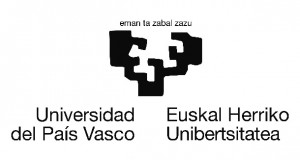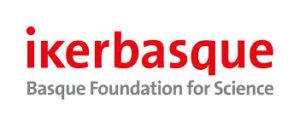Contact person: Andreas Heidenreich: email: sckheida@ehu.es
The interaction of clusters and nanodroplets (i.e., clusters with radii ≥ 10 nm) with ultraintense short near-infrared laser pulses (peak intensities IM=1014-1021 Wcm-2 pulse lengths τ = 10-250 fs, laser wavelength λ ≈ 800 nm) leads to extreme ionization, providing a tool to generate ultrahigh ion charges and kinetic energies [1-4]. Depending on the pulse parameters, first-row atoms can be completely ionized and for heavy elements like xenon up to 39 charges per atom can be achieved. Research goal is a theoretical description and modeling of these processes as well as the ion electron energetics and dynamics.
Fig. 1 depicts the basic processes which occur when a cluster is irradiated by an ultrashort ultraintense laser pulse. In the first step (a), tunnel ionization (TI) generates a few ion-electron pairs which increase the local electric field in the cluster and facilitate further ionizations (“ignition effect”), followed by a large number of classical barrier suppression ionizations (BSI). A considerable amount of the stripped electrons remains inside the cluster and forms, together with the ions, a nanoplasma within femtoseconds (Fig. 1b). The nanoplasma electrons, driven by the oscillating laser electric field, cause an avalanche of electron impact ionizations (EII). The ignition effect and the avalanche of electron impact ionizations are the reason, why much higher ion charge states are formed in clusters than for single atoms; the enhanced ionization was an unexpected effect in the first experimental discovery by the Castleman group in 1994 [5]. Depending on the pulse parameters (laser intensity and pulse length) and on the cluster size, the nanoplasma electrons are partly or completely removed from the cluster. This process is called outer ionization, as opposed to inner ionization which subsumes TI, BSI and EII of the cluster atoms. Sequentially and parallel to the inner and outer ionization process, the cluster expands, Fig. 1c, mainly because of the electrostatic repulsion of the excess positive charge of the cluster (Coulomb explosion, CE), whereas the pressure of the electron gas (hydrodynamic expansion) plays only a role in very electron-rich nanoplasmas and leads to much lower ion energies [6]. The lifetime of the nanoplasma ranges from tens of femtoseconds to several picoseconds, until the nanoplasma is diluted in the course of the cluster explosion.
The ions attain their kinetic energy from the conversion of the electrostatic repulsive energy in the cluster; the ions are too heavy to be accelerated directly by the rapidly oscillating laser electric field. Depending on the ion charges, the initial cluster/nanodroplet radius, the level and speed of the outer ionization process, the ion energies are in the keV to MeV range which is sufficient to induce nuclear fusion, if hydrogen isotopes are involved. Accordingly, possible applications of Coulomb explosions are table-top laser-induced nuclear fusion and neutron sources for material research [7-9] the study of stellar nucleosynthesis in the laboratory [10,11] (“stars in the lab” [12]), as well as particle accelerators.
Under experimental conditions, a beam of clusters or droplets with a size distribution [13] rather than a single cluster or droplet is generated. The cluster or droplet beam is crossed by the laser beam. An artistic view of CE in a small part of a cluster beam is presented in Fig. 2. Nuclear fusion can occur when either ions of different nanodroplets (or clusters) and or ions inside the same nanodroplet collide, termed as interdroplet and intradroplet nuclear fusion, respectively. Intradroplet fusion requires nuclear overrun which can occur either in nanodroplets with density inhomogeneities or, more efficiently, in nanodroplets with ions of different charge/mass ratios. While interdroplet and intradroplet fusion takes place in a droplet beam, a different concept was pursued in a source-target reaction design [14,15], consisting of a beam of exploding hydrogen or deuterium nanodroplets which is surrounded by a solid cylinder as the fusion target. In this way, the fusion efficiency Φ=Y/W, defined as the number Y of fusion events per expended laser energy W, was increased from typically ≈105 J-1 for the D +D reaction in a beam of deuterium droplets [7-9] to ≈109 J-1 for the D + 7Li reaction in the source-target design [15,16]. The four-orders of magnitude enhancement of the fusion efficiency is caused by the cumulative effect of (i) the collection of all high-energy ions by the target cylinder, (ii) relatively large cross sections of the chosen fusion reaction and (iii) by the stopping power of the target materials which generally decreases with increasing velocity of the penetrating ion projectile. In this way, a nonlinear increase of the fusion efficiency with increasing ion kinetic energy can be achieved: The task is to optimize the laser energy deposition in the nanodroplets with respect to the highest fusion efficiency. The fusion efficiency predicted for the source-target design is comparable with those currently obtained for the D + T fusion in ‘big science’ setups in the OMEGA laser system [17] and in the National Ignition Facility system [18], but at a small fraction of the costs and suitable for a university laboratory.
Trajectory calculations are a suitable method to describe the ion and electron dynamics and energetics of Coulomb explosions of clusters of atoms and small molecules [6,19,20]. The high electron kinetic energies (electrons attain almost speed of light at the highest laser intensities) require a relativistic treatment. Once every atom is at least singly ionized, the Coulomb potential prevails and makes a quantum mechanical calculation of the interparticle potentials unnecessary. However, the large number of pairwise interactions requires the development and implementation of computational strategies to treat large systems. The modeling of cluster and droplet beams requires the incorporation of light attenuation effects by energy absorption of the cluster beam and for larger nanodroplets also the inclusion of intradroplet energy absorption.
References
[1] V. P. Krainov, M. B. Smirnov, Phys. Rep. 370, 237 (2002).
[2] U. Saalmann, C. Siedschlag, and J. M. Rost, J. Phys. B: At. Mol. Opt. Phys. 39, R39 (2006).
[3] A. Heidenreich, I. Last, and J. Jortner, in O. Kühn and L. Wöste (Eds.), Analysis and Control of Ultrafast Photoinduced Processes, Vol. 87, Springer, Heidelberg 2007, p. 575.
[4] T. Fennel, K.-H. Meiwes-Broer, J. Tiggesbäumker, P. G. Reinhard, P. M. Dinh, E. Suraud, Rev. Mod. Phys. 82, 1793 (2010).
[5] J. Purnell, E.M. Snyder, S. Wei, A.W. Castleman Jr., Chem. Phys. Lett. 229, 333 (1994).
[6] A. Heidenreich, I. Infante, J. M. Ugalde, New J. Phys. 14, 075017 (2012).
[7] J. Zweiback, R. A. Smith, T. E. Cowan, G. Hays, K. B. Wharton, V. P.Yanovsky, T. Ditmire, Phys. Rev. Lett. 84, 2634 (2000).
[8] G. Grillon et al., Phys. Rev. Lett. 89, 065005 (2002).
[9] K. W. Madison, P. K. Patel, D. Price, A. Edens, M. Allen, T. E. Cowan, J. Zweiback, T. Ditmire, Phys. Plasmas 11, 270 (2004).
[10] I. Last, J. Jortner, Phys. Plasmas 14, 123102 (2007).
[11] A. Heidenreich, J. Jortner, I. Last, Proc. Natl. Acad. Sci. USA 103, 10589 (2006).
[12] Research Highlights, Nature 444, 126 (2006).
[13] A. Heidenreich, J. Jortner, J. Chem. Phys. 134, 074315 (2011).
[14] I. Last, S. Ron, J. Jortner, Phys. Rev. A 83, 043202 (2011).
[15] S. Ron, I. Last, J. Jortner, Phys. Plasmas 19, 112707 (2012).
[16] A. Heidenreich, I. Last, S. Ron, J. Jortner, Mol. Phys., accepted (March 2013).
[17] A. M. Cok, R. S. Craxton, P. W. McKenty, Phys. Plasmas 15, 082705 (2008).
[18] NIF Project Status (2011)
https://lasers.llnl.gov/newsroom/project_status/2011/september.php
[19] A. Heidenreich, I. Last, J. Jortner, J. Chem. Phys. 127, 074305 (2007).
[20] A. Heidenreich, I. Last, J. Jortner, Isr. J. Chem. 47, 89 (2007).
Contact person: Andreas Heidenreich: email: sckheida@ehu.es




